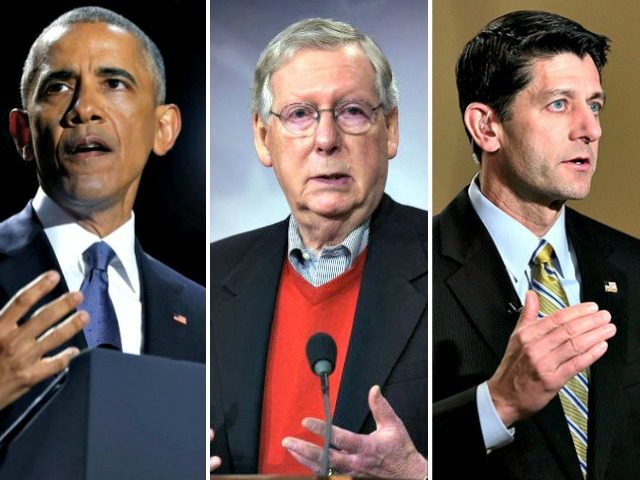The Senate healthcare bill, known as the Better Care Reconciliation Act (BCRA), offers more generous tax credits and a slower rollback of Obamacare’s Medicaid expansion compared to the House’s American Health Care Act (AHCA).
Here are some of the larger reforms of Senator Mitch McConnell’s Better Care Reconciliation Act:
Individual Mandate
Under Obamacare, people without insurance are required to purchase it or pay a penalty. The Ryan plan replaces the individual mandate penalty with a penalty payable to the health insurance companies. Individuals who forgo health insurance for longer than 63 days face a 30 percent surcharge on their health insurance premiums. Since health insurers adjust premiums based on age, older Americans face a more expensive penalty for forgoing health insurance.
The BCRA would repeal Obamacare’s individual mandate. The Senate bill will likely include a new amendment that would add a six-month waiting period for those who fail to sign up for insurance during the normal enrollment period. This provision would encourage Americans to maintain health insurance coverage throughout the year, without the burden of a health insurance penalty.
Employer Mandate
Obamacare required that businesses with 50 or more full-time employees provide their employees and dependents with health insurance. The House’s AHCA and the Senate’s BCRA both repeal Obamacare’s employer mandate.
Obamacare Taxes
Both the House and Senate bill repeal Obamacare’s $1 trillion in taxes, except for the “Cadillac tax” on high-cost employer sponsored health care plans.
Refundable Tax Credits
The House and Senate bills replace Obamacare’s subsidies for Americans to purchase health insurance with refundable tax credits. The AHCA doles out tax credits based on age, not income. The AHCA’s tax credits range from $2,000 for those under age 30 to $4,000 for those over age 60.
These credits are available for those making $75,000 or those who file jointly at $150,000, and the credit phases out by $100 for every $1,000 higher in income in these age brackets.
The Senate bill’s tax credits are means-tested and adjusted by income up to 350 percent above the poverty level. Avik Roy, president of the Foundation for Research on Equal Opportunity, contends that the Senate bill better structures its tax credits compared to the House’s system. Roy also argues that the AHCA’s flat-tax credits would create a “benefits cliff” that would price millions of near-elderly low-income Americans out of purchasing in the health insurance market and trap millions of Americans in poverty.
State Innovation Funds
The Ryan plan creates a $138 billion “Patient and State Stability Fund” that furnishes subsidies for states to provide care to high-risk individuals, stabilize private insurance premiums, promote access to preventive services, and provide cost-sharing subsidies.
The Senate’s BCRA provides $15 billion for a “State Stabilization Fund” to help lower the price of premiums and increase health coverage for 2018 and 2019. The fund would also provide $10 billion a year in 2020 and 2021. The bill also creates a $62 billion long-term state innovation fund that allows states to help high-cost patients and low-income citizens purchase health insurance.
Obamacare Insurance Regulations
Paul Ryan’s Obamacare replacement retains Obamacare’s essential health benefits, although states can obtain waivers that allow them to waive Obamacare insurance regulations such as essential health benefits and community ratings.
The essential health benefits provision requires that insurers maintain a minimum level of coverage, including emergency services, prescription drugs, laboratory services, vision, and dental. Community ratings mandate that health insurers cannot vary insurance premiums for individuals based on age, gender, location, or health status.
The CBO report of the House’s AHCA estimates that if states were to make moderate changes to Obamacare’s insurance regulations, average premiums would lower by 20 percent. However, sicker and older Americans would pay higher average premiums than under the Affordable Care Act.
The Senate bill allows states to apply for waivers for some Obamacare insurance regulations. However, states cannot apply for waivers for regulations on pre-existing conditions and coverage for young Americans. Sen. Paul explained to Breitbart News that “The bill keeps ten of twelve Obamacare regulations that cause the prices of premiums to spiral upward.”
The Senate’s BCRA does eliminate Obamacare’s essential health benefits after December 31, 2019.
Changes to Medicaid
Obamacare expanded Medicaid, which allowed more low-income Americans to purchase health insurance.Thirty-two states expanded Medicaid under Obamacare, and both the House and Senate bill make drastic changes to Medicaid.
The House’s AHCA will end Obamacare’s Medicaid expansion by 2020, after which the program would cap Medicaid spending per capita. States also have the option to block grant Medicaid, allowing states to have more control over Medicaid spending.
The Senate bill would retain Obamacare’s Medicaid expansion until 2020. In 2021, Medicaid expansion would phase out tover three years, ending in 2024. The plan would limit Medicaid spending with per capita caps, or states can decide to adopt block grants for Medicaid spending. Medicaid would grow at a slower rate starting in 2025.
The House and Senate bill would allow states to impose work requirements for Medicaid on able-bodied adults without dependents.
Read the entire Better Care Reconciliation Act here.

COMMENTS
Please let us know if you're having issues with commenting.